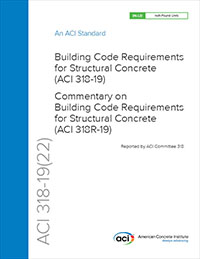American Concrete Institute: Building Code Requirements for Structural Concrete (ACI 318-19) Commentary on Building Code Requirements for Structural Concrete (ACI 318R-19) SI + IN/LB ACI, 2019 pdf, 2x628 pages, english ISBN: 978-1-64195-056-5

American Concrete Institute ACI 318 19
The Code was substantially reorganized and reformatted in 2014, and this Code continues and expands that same organizational philosophy. The principal objectives of the reorganization were to present all design and detailing requirements for structural systems or for individual members in chapters devoted to those individual subjects, and to arrange the chapters in a manner that generally follows the process and chronology of design and construction. Information and procedures that are common to the design of multiple members are located in utility chapters. Additional enhancements implemented in this Code to provide greater clarity and ease of use include the first use of color illustrations and the use of color to help the user navigate the Code and quickly find the information they need. Special thanks to Bentley Systems, Incorporated, for use of their ProConcrete software to produce many of the figures found in the Commentary.
Uses of the Code include adoption by reference in a general building code, and earlier editions have been widely used in this manner. The Code is written in a format that allows such reference without change to its language. Therefore, background details or suggestions for carrying out the requirements or intent of the Code provisions cannot be included within the Code itself. The Commentary is provided for this purpose.
Some considerations of the committee in developing the Code are discussed in the Commentary, with emphasis given to the explanation of new or revised provisions. Much of the research data referenced in preparing the Code is cited for the user desiring to study individual questions in greater detail. Other documents that provide suggestions for carrying out the requirements of the Code are also cited.
Keywords: admixtures; aggregates; anchorage (structural); beam-column frame; beams (supports); caissons; cements; cold weather; columns (supports); combined stress; composite construction (concrete to concrete); compressive strength; concrete; construction documents; construction joints; continuity (structural); contraction joints; cover; curing; deep beams; deep foundations; deflections; drilled piers; earthquake-resistant structures; flexural strength; floors; footings; formwork (construction); hot weather; inspection; isolation joints; joints (junctions); joists; lightweight concretes; load tests (structural); loads (forces); mixture proportioning; modulus of elasticity; moments; piles; placing; plain concrete; precast concrete; prestressed concrete; prestressing steels; quality control; reinforced concrete; reinforcing steels; roofs; serviceability; shear strength; shotcrete; spans; splicing; strength analysis; stresses; structural analysis; structural design; structural integrity; structural walls; T-beams; torsion; walls; water; welded wire reinforcement.
“Các Yêu cầu của Quy tắc Xây dựng đối với Bê tông Kết cấu” (“Mã”) đưa ra các yêu cầu tối thiểu về vật liệu, thiết kế và chi tiết của các tòa nhà bê tông kết cấu và, nếu có, các kết cấu phi xây dựng. Quy tắc này được phát triển bởi một quy trình đồng thuận được ANSI phê duyệt và đề cập đến các hệ thống kết cấu, thành viên và kết nối, bao gồm đúc tại chỗ, đúc sẵn, bê tông phun, trơn, không áp lực, ứng suất trước và kết cấu composite. Trong số các chủ đề được đề cập là: thiết kế và xây dựng về sức mạnh, khả năng sử dụng và độ bền; tổ hợp tải trọng, hệ số tải trọng và hệ số giảm cường độ; các phương pháp phân tích cấu trúc; giới hạn độ võng; cơ học và chất kết dính neo vào bê tông; phát triển và nối cốt thép; thông tin tài liệu xây dựng; kiểm tra, thử nghiệm hiện trường; và các phương pháp đánh giá sức bền của các cấu trúc hiện có.
Quy tắc đã được tổ chức lại và định dạng lại về cơ bản vào năm 2014, và Quy tắc này tiếp tục và mở rộng triết lý tổ chức tương tự. Các mục tiêu chính của việc tổ chức lại là trình bày tất cả các yêu cầu thiết kế và chi tiết cho hệ thống kết cấu hoặc cho các thành viên riêng lẻ trong các chương dành cho các chủ đề riêng lẻ đó, và sắp xếp các chương theo cách thường tuân theo quy trình và trình tự thời gian của thiết kế và xây dựng. Thông tin và thủ tục chung cho thiết kế của nhiều thành viên nằm trong các chương tiện ích. Các cải tiến bổ sung được triển khai trong Quy tắc này để cung cấp sự rõ ràng hơn và dễ sử dụng hơn bao gồm việc sử dụng đầu tiên các hình minh họa màu và sử dụng màu sắc để giúp người dùng điều hướng Mã và nhanh chóng tìm thấy thông tin họ cần. Đặc biệt cảm ơn Bentley Systems, Incorporated, đã sử dụng phần mềm ProConcrete của họ để tạo ra nhiều số liệu có trong Bài bình luận.
Việc sử dụng Quy tắc bao gồm việc áp dụng bằng cách tham chiếu trong một quy tắc xây dựng chung và các phiên bản trước đó đã được sử dụng rộng rãi theo cách này. Quy tắc được viết ở định dạng cho phép tham chiếu mà không cần thay đổi ngôn ngữ của nó. Do đó, các chi tiết cơ bản hoặc đề xuất để thực hiện các yêu cầu hoặc mục đích của các điều khoản của Bộ luật không thể được bao gồm trong bản thân Bộ luật. Bình luận được cung cấp cho mục đích này.
Một số cân nhắc của ủy ban trong việc xây dựng Bộ quy tắc được thảo luận trong Phần bình luận, chú trọng giải thích các điều khoản mới hoặc sửa đổi. Phần lớn dữ liệu nghiên cứu được tham chiếu trong quá trình soạn thảo Bộ quy tắc được trích dẫn cho người dùng muốn nghiên cứu chi tiết hơn các câu hỏi riêng lẻ. Các tài liệu khác cung cấp các gợi ý để thực hiện các yêu cầu của Quy tắc cũng được trích dẫn.
Từ khóa: phụ gia; tổng hợp; neo đậu (kết cấu); khung dầm-cột; dầm (giá đỡ); caissons; xi măng; thời tiết lạnh; cột (giá đỡ); căng thẳng kết hợp; xây dựng liên hợp (bê tông đến bê tông); cường độ nén; bê tông; hồ sơ xây dựng; mối nối thi công; tính liên tục (cấu trúc); co rút khớp; che; chữa khỏi; dầm sâu; cơ sở sâu sắc; sự lệch hướng; cầu tàu khoan; công trình chịu động đất; độ bền uốn; tầng lầu; móng nhà; ván khuôn (xây dựng); thời tiết nóng; kiểm tra; khớp cách ly; khớp (mối nối); người tham gia; bê tông nhẹ; thử tải (kết cấu); tải trọng (lực); tỷ lệ hỗn hợp; mô đun đàn hồi; khoảnh khắc; cọc; đặt; bê tông tạo phẳng; bê tông đúc sẵn; bê tông ứng suất trước; thép ứng suất trước; kiểm soát chất lượng; bê tông cốt thép; cốt thép; những mái nhà; khả năng phục vụ; sức chống cắt; bê tông phun; các nhịp; nối; phân tích sức mạnh; căng thẳng; phân tích cấu trúc; thiết kế cấu trúc; tính toàn vẹn của cấu trúc; tường kết cấu; Dầm chữ T; sự xoắn; những bức tường; Nước; gia cố dây hàn.

COMMENTS